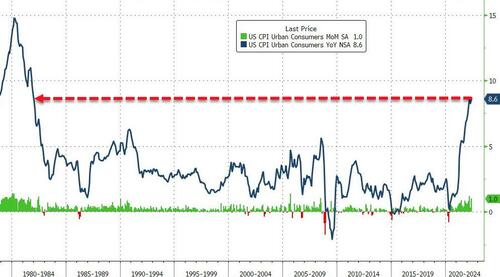Definitely not peak inflation. But my readers knew about that.
The stock markets broke down on Thursday, leading many to say, “uh oh, tomorrow’s (Friday June.10th) inflation data is probably going to be bad”. And it was.
Inflation accelerated in May, with prices rising 8.6%. The fastest increase since December 1981. This was more than the 8.3% estimate.

Excluding food and energy prices, core CPI was up 6%. Just a tad bit higher than the 5.9% estimate. On a monthly basis, headline CPI was up 1% while core rose 0.6%.
If we break down the numbers, we see that shelter, gas and food prices all contributed to the increase:
Energy prices broadly rose 3.9% from a month ago, bringing the annual gain to 34.6%. Within the category, fuel oil posted a 16.9% monthly gain, pushing the 12-month surge to 106.7%.
Shelter costs, which account for about a one-third weighting in the CPI, rose 0.6% for the month, the fastest one-month gain since March 2004. The 5.5% 12-month gain is the most since February 1991.
Finally, food costs climbed another 1.2% in May, bringing the year-over-year gain to 10.1%.
Some of the biggest increases came in airfares (up 12.6% on the month), used cars and trucks (1.8%), and dairy products (2.9%).
It doesn’t help that workers’ pay isn’t keeping up with inflation. In real terms, they are losing. Escalating prices meant workers took another pay cut during the month. Real wages when accounting for inflation fell 0.6% in April, even though average hourly earnings rose 0.3%.
Not much good out of this report. It got even more scary when the Treasury Secretary, Janet Yellen, came out two weeks ago saying she was wrong about transitory inflation. It’s scary because she suggested the government spend big, like in the trillions, because it would not cause inflation. Most of us know this is the primary reason for inflation. The current administration still downplays this and says the responsibility for lowering inflation belongs to the Fed.
Funnily enough, this means the current administration also acknowledges there is monetary inflation, and not just non-monetary inflation. For the Fed to tame inflation, interest rates need to go MUCH higher, and excess money in the system must be drained out. The latter began in June with quantitative tightening. Asset prices will fall, and the US likely is heading for a recession.
On the non-monetary inflation side of things it gets a bit more complicated. With the money printing, there is more money now competing for the same number of goods and services. Either productivity (supply) has to increase. You don’t want this to come from government spending, as this would worsen inflation. You want this to come from the private sector. Corporations spending money to hire people and increase productivity. Unfortunately, this doesn’t seem like it will happen as most corporations think we are heading to a recession. Tesla is the latest to pause hiring and trim down on their spending.
The other option? Kill demand. A recession is helpful, but people still spend money, so it all depends on how severe the recession is going to be. Many analysts now believe that China is using this approach. They continue to impose covid lockdowns in cities. Most analysts I have spoken to believe this is China killing demand to deal with rising energy and food prices. It does impact the US though because of the “Made in China” goods. Those will get a lot more expensive and just adds to America’s inflation woes.
None of these options are a surprise to regular readers. This is what I have been saying ever since inflation began creeping higher. Inflation isn’t magically going to disappear as per the transitory inflation narrative.

Yes, stock markets are falling, but the ten year yield is the chart you need to be watching. We have just broken above recent highs of 3.19%. Not going to lie folks, this has the potential to be very scary stuff. If the ten year spikes in an uncontrollable fashion, expect havoc in the stock markets and other assets. It would mean interest rates are heading much higher.
If the ten year yield begins to rise in a controllable and consistent fashion, then we can rest a bit easier. It does still mean that interest rates are heading higher. With the latest inflation data, markets are beginning to price in interest rates that will go over the normal range of 2-3% that the Fed had in mind. Essentially interest rates are going much higher than what central banks told you. In an economy that is so used to cheap money and leveraged with debt…it isn’t going to be pretty.

The US Dollar also reversed and is now breaking out. Wow.
This is huge because of the ramifications it can have on geopolitics. A stronger dollar does entice US allies to hold Dollar reserves, but it also damages some emerging markets. Especially those who have large US Dollar denominated debt. Turkey comes to mind and it looks like the Lira may be breaking out into new all time record lows even after Turkey’s central bank raised interest rates to high double digits, and took steps to have people trade in their Dollars and gold to prop the Lira. Watch Turkey for some sort of geopolitical event.
The Dollar could be rising for either two reasons. Either, people are running into the Dollar because of fear and uncertainty. People selling and going into cash. Let’s not forget that money from Asia and Europe is probably running into the Dollar for safety.
Or, the Dollar is rising because the market is now pricing in MORE rate hikes. That the Fed will be taking interest rates above the 2-3% normal threshold.
The drama continues with a Federal Reserve interest rate decision this week on June 15th. The Fed is expected to raise rates by 50 basis points, but do the markets now want 75?

